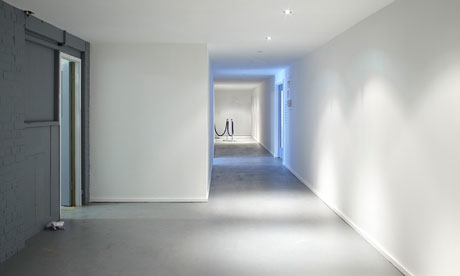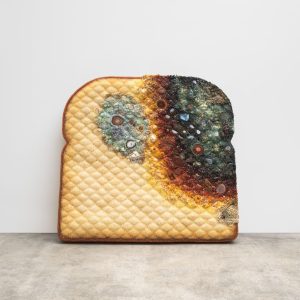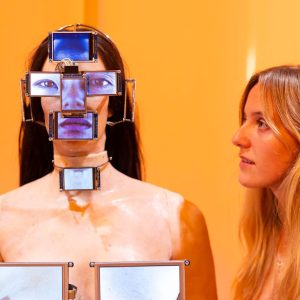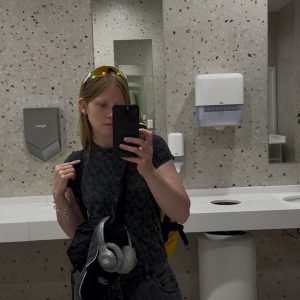
Image:Ryan Gander’s Artangel installation, Locked Room Scenario: ‘It’s difficult to know what is real and what is staged.’ Photograph: Julian Abrams
In Agatha Christie’s short story “Dead Man’s Mirror”, the redoubtable Hercule Poirot is summoned by train to a stately home in the country by Sir Gervase Chevenix-Gore. When he arrives he finds that no one is expecting him and that Sir Gervase himself is missing. The murder mystery begins in earnest when Poirot discovers Sir Gervase’s body in the study.
What appears to be a straightforward case of suicide turns out, inevitably, to be a meticulously planned murder carried out by one of the guests. “Dead Man’s Mirror” is a classic “locked room” mystery, in which a murder takes place in a seemingly impossible location, in this case a study that no one could have entered or left without forcing an entry or being detected.
In Ryan Gander’s latest site-specific artwork, Locked Room Scenario, the visitor is invited to play Poirot in order to solve the mystery of a group show to which they are denied access. The installation was commissioned by Artangel, a company dedicated to taking art beyond the confines of the gallery wall, and whose past successes have included Rachel Whiteread’s House (1993), a life-size cast of a Victorian house in London’s East End, Michael Landy’s Break Down (2001), in which the artist publicly destroyed everything he owned, and Jeremy Deller’s The Battle of Orgreave (2001), his restaging of the bloody battle between police and striking miners that took place on 18 June 1984.
Gander is a young British artist already adept at labyrinthine mind games. He was shortlisted for the Becks Futures prize in 2005 for a piece called Bauhaus Revisited which paid homage to Josef Hartwig’s 1924 chess set, where the shape of the pieces gave clues as to how they should be moved. His work, he says, is more akin to novel writing than fine art, though on this evidence Borges or Kafka, rather than Agatha Christie, are his touchstones.
To visit Locked Room Scenario, which is situated in a disused warehouse space in Hoxton, east London, you must first apply for places online and submit your mobile phone number. Eight people at a time will be admitted, though you will probably encounter other individuals, whose purpose is less clear, as you move in and around the warehouse where the locked-in group show is supposedly housed.
From the off, it’s difficult to know what is real and what is staged, and this sense of disjuncture begins long before you enter the show – with a mysterious text message – and after you leave, with a possible mysterious encounter with a passing stranger. I experienced the former but not the latter, unless the smiling man going in as I came out was an actor posing as a visitor.
The text message, which came early on the morning of my visit, read: “I’ll wait in the Wenlock 10 mins before. Spencer A.” I never made it to the Wenlock Arms, a nearby pub, as I took the wrong turning off City Road and wandered up and down several side streets in search of the site.
Inside the Londonewcastle building itself you are immediately confronted by a dark stairwell on which skulk two young people who look like crackheads but could simply be dishevelled Hoxton hipsters. Or actors. I lingered, Poirot-like, in the adjacent dark hallway and tried to eavesdrop on their conversation, but only the swear words were audible. From inside the brightly lit room ahead, the sound of approaching footsteps. It turned out to be another art critic, notebook in hand, who passed me with a wry smile that made me think maybe he wasn’t in fact an art critic at all, but another actor. This is the essence of Ryan Gander’s elaborate mind game: to make you question what is real and what is not, and, more intriguingly, to make your imagination work overtime in the way it might were you reading a superior crime novel rather than attending an art show that borrows some of the tropes of the same.
Doors are a key feature of the installation: some are locked and some open on to long, dark corridors featuring small illuminated windows. Through one I glimpse what might be the interior of a cell or a particularly glum bathroom. In another, a backwards mirror message has me grimacing to decipher its meaning. It reads: “Always the Wrong Side”. This, I think, is as close as conceptual art gets to a punchline.
A long, bright corridor leads to a glass door which looks like the entrance to a group show called Field of Meaning, except that it’s locked. I study the names of the artists printed on the wall for a glimmer of recognition – Mary Aurora, Rose Duvall, Abbe Faria, Spencer A (my elusive text friend!). Then I notice a glimmer of human movement behind the glass: a woman seems to be moving things about, or sweeping up, or enacting a performance.
Behind me, a room contains a pile of unopened mail addressed to Spencer Anthony, Kimberley Gallery. I am starting to hate Spencer, whether he exists or not. On a rack nearby are postcards bearing the names of the artists in the show and examples of their work: blurry photographs mostly, including one of a big blue fleece I glimpsed in a rubbish skip outside. The plot thickens, but to what end I have no idea.
On another wall a mysterious art timeline begins with the birth of Abbé Faria in 1935. The (fictional?) Wikipedia entry for Abbé Faria has him down as a “colourful Goan Catholic monk who was one of the pioneers of the scientific study of hypnotism” and someone who “understood that it worked purely by the power of suggestion”.
Locked Room Scenario is essentially a show about the power of suggestion. How much you enjoy it may well depend on your level of susceptibility to the various clues, half clues, scraps of meaning and allusion that are scattered throughout in this elaborate otherworld that mirrors and distorts our own. I personally came away more frustrated than intrigued.
Why is there an electric-blue fleece in a rubbish tip? Who is sawing upstairs and why? Who is Mary Aurora and why has someone said sorry to her via a graffiti message?
I put these questions to Ryan Gander, who was hanging around outside the day I visited, but he was not telling. He talked a lot about “para-possible realities” and “other versions of the everyday”, and his imagination being “so hyperactive that it has gone so far beyond itself that I no longer know what’s fiction and reality any more”.
I felt the same as I walked up the road towards Old Street, feeling more like Josef K than Poirot. It took a while to shake off the sense that every approaching stranger might be in on Gander’s conceptual mind game, which may, of course, say more about me than the work.
guardian.co.uk © Guardian News & Media Limited 2010
Published via the Guardian News Feed plugin for WordPress.







